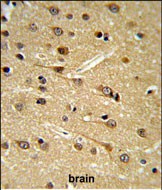DPP10 Antibody (Center)
Affinity Purified Rabbit Polyclonal Antibody (Pab)
- SPECIFICATION
- CITATIONS
- PROTOCOLS
- BACKGROUND

Application
| IHC-P, WB, E |
|---|---|
| Primary Accession | Q8N608 |
| Reactivity | Human, Mouse |
| Host | Rabbit |
| Clonality | Polyclonal |
| Isotype | Rabbit IgG |
| Calculated MW | 90888 Da |
| Antigen Region | 150-177 aa |
| Gene ID | 57628 |
|---|---|
| Other Names | Inactive dipeptidyl peptidase 10, Dipeptidyl peptidase IV-related protein 3, DPRP-3, Dipeptidyl peptidase X, DPP X, Dipeptidyl peptidase-like protein 2, DPL2, DPP10, DPRP3, KIAA1492 |
| Target/Specificity | This DPP10 antibody is generated from rabbits immunized with a KLH conjugated synthetic peptide between 150-177 amino acids from the Central region of human DPP10. |
| Dilution | IHC-P~~1:50~100 WB~~1:1000 E~~Use at an assay dependent concentration. |
| Format | Purified polyclonal antibody supplied in PBS with 0.09% (W/V) sodium azide. This antibody is purified through a protein A column, followed by peptide affinity purification. |
| Storage | Maintain refrigerated at 2-8°C for up to 2 weeks. For long term storage store at -20°C in small aliquots to prevent freeze-thaw cycles. |
| Precautions | DPP10 Antibody (Center) is for research use only and not for use in diagnostic or therapeutic procedures. |
| Name | DPP10 |
|---|---|
| Synonyms | DPRP3, KIAA1492 |
| Function | Promotes cell surface expression of the potassium channel KCND2 (PubMed:15454437). Modulates the activity and gating characteristics of the potassium channel KCND2 (PubMed:15454437). Has no dipeptidyl aminopeptidase activity (PubMed:12662155). |
| Cellular Location | Cell membrane {ECO:0000250|UniProtKB:Q6NXK7, ECO:0000269|PubMed:14566338}; Single-pass type II membrane protein {ECO:0000250|UniProtKB:P42658} |
| Tissue Location | Found in serum, T-cells and brain (at protein level). Expressed in brain, pancreas, spinal cord and adrenal glands |

Thousands of laboratories across the world have published research that depended on the performance of antibodies from Abcepta to advance their research. Check out links to articles that cite our products in major peer-reviewed journals, organized by research category.
info@abcepta.com, and receive a free "I Love Antibodies" mug.
Provided below are standard protocols that you may find useful for product applications.
Background
DPP10 is a single-pass type II membrane protein that is a member of the S9B family in clan SC of the serine proteases. This protein has no detectable protease activity, most likely due to the absence of the conserved serine residue normally present in the catalytic domain of serine proteases. However, it does bind specific voltage-gated potassium channels and alters their expression and biophysical properties.
References
Blakey J.D., et.al., Thorax 64:381-387(2009).
If you have used an Abcepta product and would like to share how it has performed, please click on the "Submit Review" button and provide the requested information. Our staff will examine and post your review and contact you if needed.
If you have any additional inquiries please email technical services at tech@abcepta.com.













 Foundational characteristics of cancer include proliferation, angiogenesis, migration, evasion of apoptosis, and cellular immortality. Find key markers for these cellular processes and antibodies to detect them.
Foundational characteristics of cancer include proliferation, angiogenesis, migration, evasion of apoptosis, and cellular immortality. Find key markers for these cellular processes and antibodies to detect them. The SUMOplot™ Analysis Program predicts and scores sumoylation sites in your protein. SUMOylation is a post-translational modification involved in various cellular processes, such as nuclear-cytosolic transport, transcriptional regulation, apoptosis, protein stability, response to stress, and progression through the cell cycle.
The SUMOplot™ Analysis Program predicts and scores sumoylation sites in your protein. SUMOylation is a post-translational modification involved in various cellular processes, such as nuclear-cytosolic transport, transcriptional regulation, apoptosis, protein stability, response to stress, and progression through the cell cycle. The Autophagy Receptor Motif Plotter predicts and scores autophagy receptor binding sites in your protein. Identifying proteins connected to this pathway is critical to understanding the role of autophagy in physiological as well as pathological processes such as development, differentiation, neurodegenerative diseases, stress, infection, and cancer.
The Autophagy Receptor Motif Plotter predicts and scores autophagy receptor binding sites in your protein. Identifying proteins connected to this pathway is critical to understanding the role of autophagy in physiological as well as pathological processes such as development, differentiation, neurodegenerative diseases, stress, infection, and cancer.



